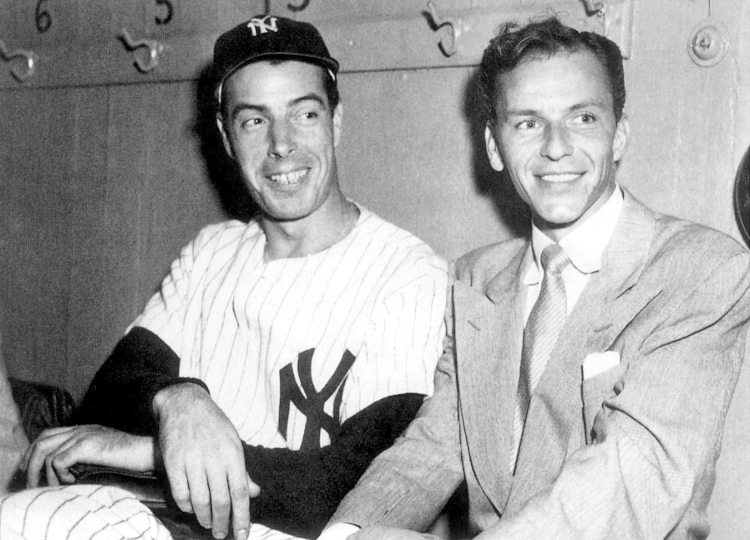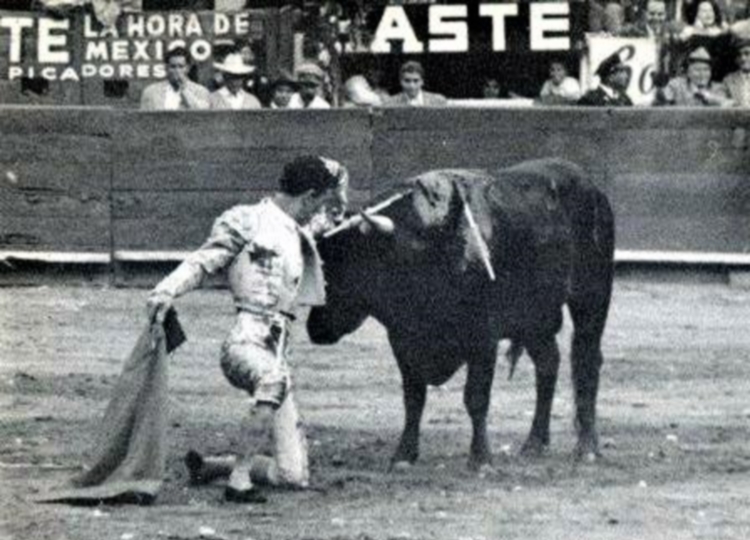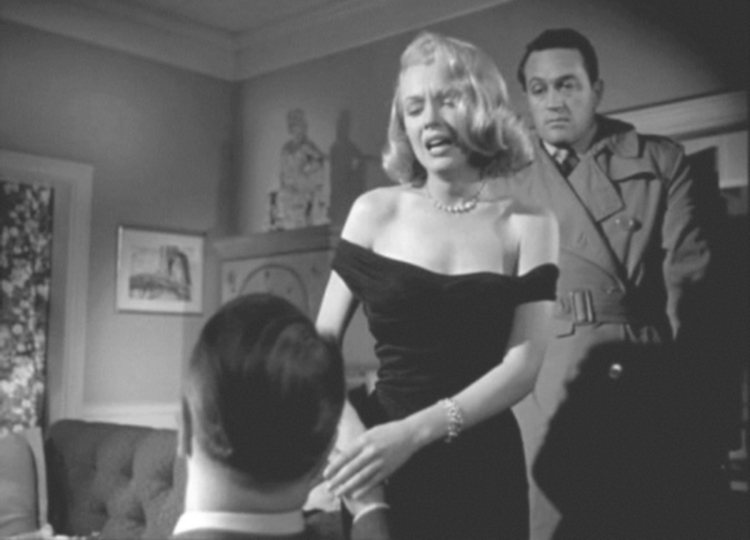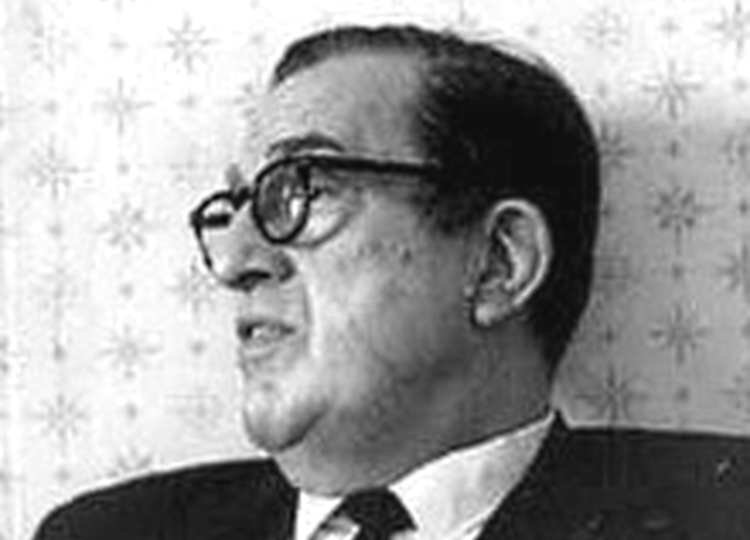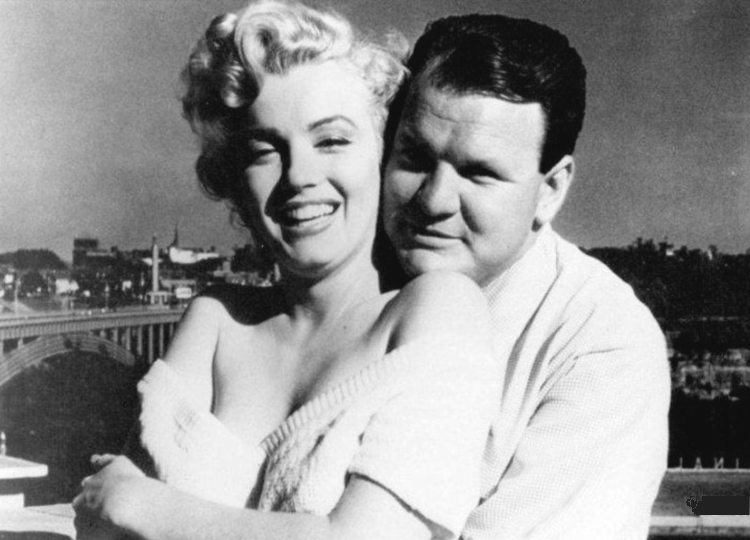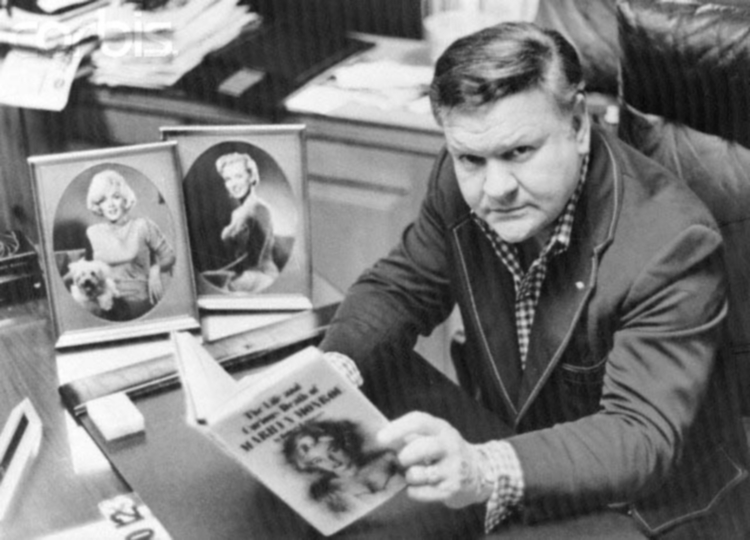An Alleged Second Husband
Ohio born newspaper reporter, writer and small time movie dilettante Robert Franklin Slatzer, appeared in the Realm of Marilyn in 1952 while she was filming Niagara. After making a slight nuisance of himself, Robert F virtually disappeared until 1973 when publicity in the form of magazine and newspaper articles along with a synopsis of a soon to be controversial book, The Life and Curious Death of Marilyn Monroe, its authorship credited to Slatzer, began to appear here and there across the nation. Eventually, in 1974, Slatzer’s book appeared on the shelves of brick and mortar book shops in America.
Several decades have come and gone since Pinnacle published Slatzer’s book. The anecdotes recounted on the narrative’s pages, and the conspiracy theory surrounding Marilyn’s unfortunate death presented therein, remain controversial; and despite that controversy, many of the biographers and pathographers who penned books about Marilyn after Slatzer’s 1974 publication, frequently quoted and frequently referenced that text. He and his book have been arguably the most frequently cited source regarding Marilyn’s life and her death. Within the text of his Marilyn pathography, for example, Anthony Summers, mentioned or otherwise referenced Slatzer one-hundred and seventy-nine times while also declaring that Slatzer’s claims were factual. Summers asserted that he believed Slatzer. Curious, to say the least, a curiousness clarified by the revelations contained in Will Fowler’s collected papers.
In addition to providing many interviews and appearing on many gossip oriented talk shows, Slatzer also finagled two television events featuring his participation, Marilyn and Me, a made for TV movie that used Slatzer’s 1974 publication as its foundational basis, and The Marilyn Files, a made-for-TV docudrama, featuring co-hosts Bill Bixby and Jane Wallace. KTLA News 5 broadcast that program live from Hollywood. The Marilyn Files used Slatzer’s eponymous 1992 publication as its foundational basis and featured the testimony of many well-known names and familiar faces.1The Marilyn Files: Live from Hollywood. Produced by Producers Video Inc. Executive producers: Melvin Bergman, William Speckin. Co-executive producers: Stan Corwin, Andrew Ettinger. Director: Bill Foster.
The slightly ersatz investigative analysis of the purported facts and circumstances surrounding Marilyn’s death, as presented by The Marilyn Files, also featured a panel of district attorneys and prosecutorial-like questioning of several pertinent witnesses. The members of the prosecutorial legal panel were: Jon Munier, a former Houston Texas Assistant District Attorney; Charles Graddick, a former Alabama Attorney General; Kate Baird, a former Kansas City Kansas Assistant District Attorney; Joseph Fusco, a former New Jersey prosecutor; and Mary Tousignant, a former York County Maine District Attorney. The unsworn testimony offered by Clemmons and Miner, along with the testimony offered by others who appeared during The Marilyn Files, will be featured throughout the text that follows hereafter.
The importance of knowing as much as we can possibly know about Slatzer’s veracity and his propensity to exaggerate and prevaricate cannot be understated. While many persons, excluding me, still accept Slatzer’s assertions, many do not. Still, there are those who also assert that Slatzer was an honest man. Anthony Summers, for instance; but there are those, including me, who assert that Slatzer was not an honest man. What follows are examples of his dishonesty.
Dorothy Kilgallen, the New York City gossip columnist who appeared in the previous section, was acquainted with Slatzer apparently; and she mentioned him in one of her columns, mentioned him as a dark horse in the Marilyn Monroe romance derby and mentioned him as a generous soul who gifted the actress with her most favorite gift: books. Undoubtedly, Slatzer was the source for that tidbit of gossip; and he frequently asserted: before Marilyn met him, she was not a reader and did not even own a book. Slatzer claimed that he generated her desire and quest for knowledge. Odd. In 1946, Slatzer’s bookless and unknowledgeable friend moved into the Studio Club. Her roommate at that time, Clarice Evans, testified: Norma Jeane’s personal collection of over two-hundred books could have allowed her to start a lending library (Vitacco-Robles v1:112). Obviously, then, Slatzer was just mistaken or, more than likely, he simply lied.
Slatzer substituted for Kilgallen during her vacation absence in 1952 and wrote her column, “Voice of Broadway”. He proclaimed therein: I am a man with an enviable task, that of telling the facts of literary life to Marilyn Monroe. He added that he had mailed to her dozens of books from his personal library, that he and Marilyn enjoyed
an adventure together even when we are 3,000 miles apart. But it is strictly of the mind. […] I got into the education of Marilyn in 1947 when she was Norma Jean Baker, a bit player for 20th Century-Fox. […] the nervous girl of 19 and I became friends. […] I didn’t see her again until last June in Niagara Falls. […] I did not know that Norma Jean was now Marilyn.2“Unraveling the Slander of Marilyn Monroe” by April VeVea.
<http://slanderofmarilynmonroe.blogspot.com/p/blog-page.html>
Ignoring that Slatzer misspelled Norma Jeane’s middle name and also ignoring that she turned twenty-one years old on June the 1st in 1947, the preceding admission certainly contradicted his 1974 memoir. Therein Slatzer asserted that he met the future Marilyn Monroe during the summer of 1946; they were together repeatedly; they were constantly in contact during the sixteen year relationship which followed their alleged meeting at the offices of 20th Century-Fox Film Corporation. Maybe Slatzer was afflicted with a poor memory and merely forgot about his 1952 “Voice of Broadway” column. Or maybe, yet again, he merely lied.
In May of 1957, while Marilyn was married to Arthur Miller, the gossip magazine Confidential published an article written by Tom Wallace based on information provided to him by Robert Slatzer. In short, the story recounted a sofa romp, a sexual episode that Slatzer claimed he enjoyed with Marilyn in 1952 while she lived on Castilian Drive with Joe DiMaggio. According to Slatzer’s sexual confect, the Yankee Clipper was out-of-town at the time, in New York City for a planned television appearance. Joe’s television appearance briefly interrupted Slatzer’s alleged sexual calisthenics with Marilyn, who had to watch the television: Joe just might question her about the program. Slatzer also claimed in another article that he enjoyed a similar sexual conquest of Marilyn in 1952 at the General Brock Hotel while she was visiting the Canadian waterfalls and performing sensuously in the movie Niagara.
Both articles referred to Marilyn in vulgar terms, labeled her Glamour Puss, Joe’s Pigeon and Miss Swivel-hips, called the sexual episodes enjoyed by Slatzer, Bedlam in the Boudoir, which would have worked as the title of a Three Stooges short. Still, considering how Marilyn invariably reacted when someone in her coterie of acquaintances and friends spoke to the press about her private life, after those articles appeared, if Slatzer had shared any brand of relationship with Marilyn at all in 1957, she would have terminated it immediately; and she never would have spoken to Slatzer again. Never.
Additionally, those lurid articles also stand as an unmitigated and undeniable contradiction to everything Slatzer alleged in his 1974 account of his lengthy relationship with Marilyn, not only in their tone but also in their crude disregard for the feelings of her then husband, Arthur Miller, for the feelings of her then ex-husband, Joe DiMaggio and for Marilyn’s feelings as well. The Confidential article will appear again later in this section.
On August the 11th in 1962, just three days after Marilyn’s funeral, the Columbus Star featured an article in what must have been that newspaper’s gossip section, “Tattle Tales.” Written by Paul Pry, Jr., the article was entitled: “Old Buddy Slatzer Reviews Marilyn Monroe’s Emotions.”3WRFC, Folder 24, File 5, pages 84 and 85.While Will Fowler definitely implanted the “I-Was-Married-To-Marilyn-Monroe” idea in Slatzer’s mind, as will be clearly shown later by the Fowler Papers, and that implantation led ultimately to Slatzer’s brazenly fraudulent memoir, the Star article certainly represents the nascence of Slatzer’s elaborately fabricated fantasy pertaining to his relationship with the famous blonde movie star. Additionally, with Marilyn gone from Planet Earth, Slatzer could assert anything his obsession with her and his imagination could concoct; and so, a scrupulous interpretation of the preceding facts can lead to only one conclusion: Robert Franklin Slatzer did not share an honest man’s compunction or aversion of lying.
Born in Marion, Ohio, on April the 4th in 1927, certainly in a relative sense, Slatzer was an accomplished person even though for a large portion of his life, he was virtually unknown, at least to most of the world’s population. In 1968, Slatzer wrote and directed Hellcats; and in 1970, he wrote and directed Bigfoot, both D-grade movies involving biker gangs, one of which was comprised of females. The cinema critics were unkind. For example, renown cinema critic, Roger Ebert, reviewed Bigfoot on the 1st of January in 1971; however, Ebert did not mention Slatzer in the review. Ebert questioned his reasons for even watching and reviewing the movie and awarded it 1½ stars. Also in 1970, Slatzer apparently directed John Wayne in a Vietnam War propaganda film entitled No Substitute for Victory. However, Slatzer’s directorship was not credited.
How Slatzer occupied himself during the first two years following 1970 is unknown or at best unclear. Perhaps he returned to Marion and wrote for the Marion Star. Perhaps he relocated to Columbus, where he wrote for the Columbus Dispatch or The Columbus Citizen-Journal or some other local newspaper. At any rate, Slatzer eventually returned to Los Angeles where he encountered writer and journalist, Will Fowler, and entered into a curious literary relationship with him. That relationship led directly to a brazen literary scam that would make Slatzer exceptionally famous, possibly even wealthy.
Approximately one year after the publication of Norman Mailer’s fiscally successful biographical novel starring Marilyn, Slatzer published his biographical novel, his first narrative, also starring Marilyn, a faux memoir, a faux autobiography of sorts that memorialized his alleged relationship with the beautiful movie star while also advancing the Kennedy-based murder conspiracy theory unveiled and started by Frank Capell and subsequently advanced by Norman Mailer. The chaotic composition of The Life and Curious Death of Marilyn Monroe led Will Fowler to create “The William Randolph Fowler Collection,” an aggregation of documents pertaining to the composition of that book, documents that will assume a significant position and role in this section hereafter.
In 1977, Slatzer became the credited executive producer of a comic western, The West Is Still Wild, also known as Mule Feathers, a movie that involved a talking mule and a search for gold. In 1981 and again in 1985, Donald Shepherd, a literary agent who also appears herein later, published two biographies crediting Slatzer as co-author, the first entitled Bing Crosby: The Hollow Man and the second entitled Duke: The Life and Times of John Wayne. The literary critics were as unkind to the Shepherd–Slatzer writing team as the cinema critics had been to Slatzer’s D-grade movies. Additionally, Carroll S. Carroll, the lead writer for Crosby’s Kraft Music Hall, wrote a review of The Hollow Man which appeared on Steven Lewis’ Bing Crosby Internet Museum. Carroll opined: There is probably a way of writing these sneering, finger-pointing bios with some measure of class, charm and technical skill, but Messrs. Shepherd and Slatzer unfortunately haven’t hit on it. Kirkus Reviews labeled the Crosby biography a nasty, old-fashioned, much padded hatchet job.4A link to the Kirkus review of Hollow Man.
<https://www.kirkusreviews.com/book-reviews/donald-robert-f-slatzer-shepherd/bing-crosby-the-hollow-man/>Christopher Schemering, a critic for Library Journal, noted that the book was marred by gratuitous editorializing and lack of critical acumen while Terry Teachout, a critic for National Review, referred to Shepherd and Slatzer as a couple of literary hacks. Based on some comments from persons who read the Wayne biography, apparently that book does not qualify as a Wayne hagiography; and there are indications, other reviews and comments by those who read the books suggesting that each author was willing to put an elliptical twist on the truth and did not necessarily let historical facts encumber them.5“Clumsy Hatchetmen Maul Crosby’s Memory in Crude Book” by Carroll S. Carroll. The article also includes the Christopher Schemering and Terry Teachout reviews. Carroll was born Carroll S. Weinschneck in 1902. In 1936, he became the lead writer for Crosby’s Kraft Music Hall. He also wrote for George Burns and Gracie Allen, Edgar Bergen and Milton Berle, just to mention a few. Carroll has been credited with helping Crosby develop his friendly, laid back radio persona.
<http://stevenlewis.info/crosby/index.html>
<http://stevenlewis.info/crosby/hollowman.htm>
We can conclude, I believe, that Slatzer was willing to engage in fictionalizing, a point better demonstrated later in this section.
Eventually, though, Slatzer settled into his new and lucrative profession, that of being Marilyn’s ex-husband; and as a result thereof, he became a Marilyn expert and historian, the narrator of Marilyn Monroe’s life story. Slatzer added a wrinkle to that story, a detail that no one could have anticipated. He claimed that he was Marilyn’s most trusted confidant during most of her adult life and that he secretly married her in 1952, unquestionably the most controversial assertion in the book. The marriage, Slatzer claimed, occurred during the time when Marilyn was romantically involved with but before she married the Yankee Clipper. Therefore Slatzer, not Joe DiMaggio, who was still among the living in 1974, appeared to be Marilyn’s second spouse.
According to Slatzer’s 1974 account, he and Marilyn encountered each other for the first time in the lobby of 20th Century-Fox Film Corporation on a summer day not unlike many other summer days; and not long after he had arrived in the City of Angels with plans and aspirations to make a successful life for himself as a writer. The beautiful brown-haired girl Slatzer encountered was still Norma Jeane then, embroiled in her modeling career, but hoping to become an actress. Their personalities meshed immediately, he asserted; and she agreed to a date for that night. They went to dinner and then to a beach where Norma swam nude; Slatzer’s account of that date with his new, sexy and gorgeous friend implied that they became lovers on their first night at the beach together; they became sexually conjoined best friends.
While at times they were often separated by long distances, the lovers maintained their relationship via the national telephone lines; and the intimate friends frequently discussed marriage, according to Slatzer. Finally in 1949, when they found themselves together in southern California, they decided to tie the connubial knot; but intoxication caused by imbibing too much champagne while sitting in Slatzer’s car thwarted that decision: they fell asleep but awoke to the gentle embrace of morning, the gentle embrace of each other’s arms and the ungentle pounding of headaches.
Three years came and went. In October of 1952, they found themselves together again in southern California; and their conversations veered once again to the subject of marriage. They decided on the 3rd of October to finally become a married couple, even though, according to Slatzer, they were already psychologically married: they had experienced some sort of Vulcan mind meld and did not need an authoritarian piece of paper to validate or prove that between them there was a nexus. Originally they decided to drive to Yuma, Arizona; but during a telephone conversation which continued into the small morning hours of October the 4th in 1952, they decided to wed in Tijuana, Mexico, immediately across the border from San Diego. Marilyn wanted to use her maiden name, Norma Jeane Mortenson; and she also wanted to keep their marriage a secret, at least temporarily, she informed Slatzer.
Within Slatzer’s narrative about Marilyn’s life and curious death, he dedicated a chapter to that all important and life changing marital event, “Weekend In Mexico.” As a result thereof, the author became famous almost overnight; but perhaps you share my consternation regarding this oddity: why did Robert Slatzer wait twelve years after Marilyn’s death and twenty-two years after he allegedly married her in Tijuana to publish his memoir and tell his story? He was, after all, according to him, the most intimate friend of, and was married to, the world’s most famous cinema icon. Most men would have announced that to the entirety of humanity almost immediately, and most certainly to all of his male buddies; but Slatzer neither revealed nor even mentioned to any living soul, prior to 1974, that he had married Marilyn Monroe in Mexico in 1952; and too, why the year of 1974? What was significant about that year?
In his memoir about his relationship with Marilyn, John Gilmore asserted that he knew Slatzer; and according to the gonzo journalist, Norman Mailer’s 1973 literary success and publicity motivated Slatzer’s literary endeavor, his ears adroitly tuned to Mailer’s jingling pockets. Gilmore stated that Slatzer hastily cobbled together his fraudulent fabrication, filled it with bold-faced lies about someone he never knew, whipped together the kind of tale that Pinnacle, Slatzer’s publisher, was eager to get into circulation on the tail of Mailer’s publicity (Gilmore KE:19). In Gilmore’s assessment, like Mailer, a need for money and old-fashioned greed motivated Slatzer’s actions and his literary endeavor starring Marilyn Monroe.
Gilmore also mentioned Slatzer’s alleged Confidential sofa romp. When apprised of the Confidential article, Gilmore noted in his memoir, Marilyn expressed bewilderment and couldn’t understand why someone she never knew was saying such things about her (Gilmore KE:19). Fox instructed her to ignore the article, told her that the studio would deal with the offending culprit; but the studio failed to act on Marilyn’s behalf.
Early in her Hollywood career, Marilyn became the object of untruthful statements and hurtful rumoring, some of which she allowed to be planted by the studio for the benefit of gaining publicity. However, by 1962, the appearance of rumors about her had grown to be an aggravation. In his memoir, Marilyn: Her Life in Her Own Words, George Barris reported that she angrily commented to him: Lies, lies, lies, nothing but lies. Everything they’ve been saying about me is lies (Barris 4). George Barris was one of Marilyn’s many photographers and also her friend. Sam Shaw, also a photographer and friend, humorously commented: If Marilyn slept with every guy that claims he was with her, she would have never had time to make any movies. Remarkably, sixty-one years after her death, the old rumors frequently resurface while dishonest individuals often create new and defamatory ones to beguile and titillate. Ironically, too, some sensationalists have even alleged that Sam Shaw was one of Marilyn’s many lovers. So the Confidential article featuring Slatzer’s alleged sofa romp with Marilyn was not a solitary slander or injustice.
Certainly, allowing Slatzer to lie with impunity, especially while Marilyn was alive and could have directly contradicted Slatzer’s slanders, only served to embolden him; and certainly, in Gilmore’s opinion, 20th Century-Fox made a mistake. In a certain respect, a fellow could argue this: the nonchalant studio indirectly shares the responsibility for the mythology ultimately created by Slatzer; and Gilmore’s opinion that greed motivated Slater’s literary scam might contain more than just a scintilla of truth. Even so, the controversial nature of Slatzer’s publication, and the many odd assertions presented therein, afforded him an amazing and fortuitously lucrative, virtually a lifelong career, that of being Marilyn Monroe’s former husband and an expert regarding her life; but was he? Let us revisit what Slatzer alleged in his book’s most curious and controversial chapter.


